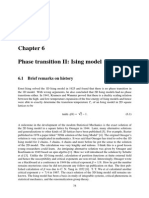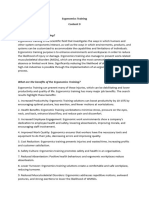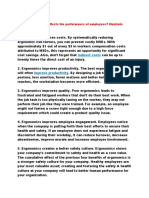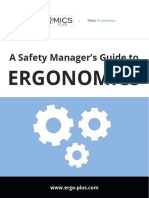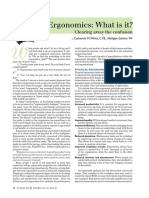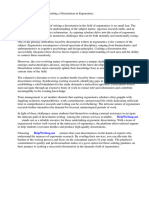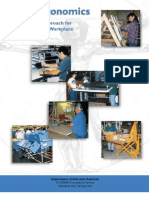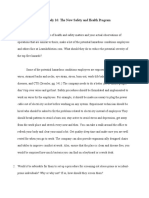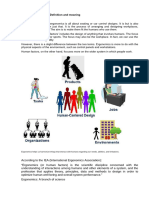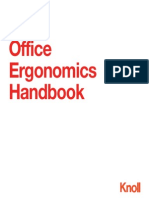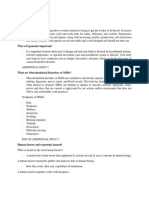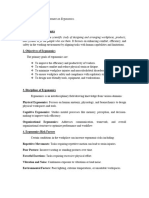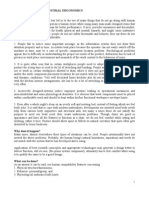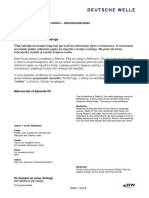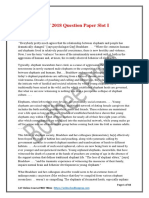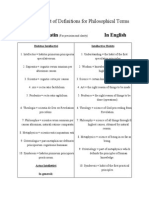0 ratings0% found this document useful (0 votes)
58 viewsErgonomics
Ergonomics
Uploaded by
master simbadThis document discusses ergonomics and its benefits. Ergonomics is the process of designing workplaces, products, and systems to fit human abilities and limitations. It aims to create safe, comfortable work environments. The benefits of ergonomics include reducing costs from injuries, improving productivity and quality by designing efficient workstations, enhancing employee engagement, and fostering a stronger safety culture.
Copyright:
© All Rights Reserved
Available Formats
Download as DOCX, PDF, TXT or read online from Scribd
Ergonomics
Ergonomics
Uploaded by
master simbad0 ratings0% found this document useful (0 votes)
58 views1 pageThis document discusses ergonomics and its benefits. Ergonomics is the process of designing workplaces, products, and systems to fit human abilities and limitations. It aims to create safe, comfortable work environments. The benefits of ergonomics include reducing costs from injuries, improving productivity and quality by designing efficient workstations, enhancing employee engagement, and fostering a stronger safety culture.
Original Title
ergonomics
Copyright
© © All Rights Reserved
Available Formats
DOCX, PDF, TXT or read online from Scribd
Share this document
Did you find this document useful?
Is this content inappropriate?
This document discusses ergonomics and its benefits. Ergonomics is the process of designing workplaces, products, and systems to fit human abilities and limitations. It aims to create safe, comfortable work environments. The benefits of ergonomics include reducing costs from injuries, improving productivity and quality by designing efficient workstations, enhancing employee engagement, and fostering a stronger safety culture.
Copyright:
© All Rights Reserved
Available Formats
Download as DOCX, PDF, TXT or read online from Scribd
Download as docx, pdf, or txt
0 ratings0% found this document useful (0 votes)
58 views1 pageErgonomics
Ergonomics
Uploaded by
master simbadThis document discusses ergonomics and its benefits. Ergonomics is the process of designing workplaces, products, and systems to fit human abilities and limitations. It aims to create safe, comfortable work environments. The benefits of ergonomics include reducing costs from injuries, improving productivity and quality by designing efficient workstations, enhancing employee engagement, and fostering a stronger safety culture.
Copyright:
© All Rights Reserved
Available Formats
Download as DOCX, PDF, TXT or read online from Scribd
Download as docx, pdf, or txt
You are on page 1of 1
Name: Tesiorna, Jerecho D.
Subject Code: ENGR1004 Date: October 5, 2019
What is Ergonomics?
Ergonomics - is the process of designing or arranging workplaces, products and
systems so that they fit the people who use them.
Ergonomics (or ‘human factors’ as it is referred to in North America) is a branch of
science that aims to learn about human abilities and limitations, and then apply this
learning to improve people’s interaction with products, systems and environments.
Ergonomics aims to create safe, comfortable and productive workspaces by bringing
human abilities and limitations into the design of a workspace, including the individual’s
body size, strength, skill, speed, sensory abilities (vision, hearing), and even attitudes.
5 Benefits of Ergonomics
1. Ergonomics reduces costs. By systematically reducing ergonomic risk factors, you
can prevent costly MSDs. With approximately $1 out of every $3 in workers
compensation costs attributed to MSDs, this represents an opportunity for significant
cost savings. Also, don’t forget that indirect costs can be up to twenty times the direct
cost of an injury.
2. Ergonomics improves productivity. The best ergonomic solutions will often improve
productivity. By designing a job to allow for good posture, less exertion, fewer motions
and better heights and reaches, the workstation becomes more efficient.
3. Ergonomics improves quality. Poor ergonomics leads to frustrated and fatigued
workers that don’t do their best work. When the job task is too physically taxing on the
worker, they may not perform their job like they were trained. For example, an employee
might not fasten a screw tight enough due to a high force requirement which could
create a product quality issue.
4. Ergonomics improves employee engagement. Employees notice when the company
is putting forth their best efforts to ensure their health and safety. If an employee does
not experience fatigue and discomfort during their workday, it can reduce turnover,
decrease absenteeism, improve morale and increase employee involvement.
5. Ergonomics creates a better safety culture. Ergonomics shows your company’s
commitment to safety and health as a core value. The cumulative effect of the previous
four benefits of ergonomics is a stronger safety culture for your company. Healthy
employees are your most valuable asset; creating and fostering the safety & health
culture at your company will lead to better human performance for your organization.
REFERENCE: https://www.ergonomics.com.au , https://ergo-plus.com/workplace-ergonomics-
benefits/
You might also like
- LESSON 1 Introduction To ErgonomicsDocument10 pagesLESSON 1 Introduction To ErgonomicsRyan Sinday AcojedoNo ratings yet
- Introduction To Industrial ErgonomicsDocument71 pagesIntroduction To Industrial ErgonomicsArifdho Yanata100% (3)
- Ch6 Phase Transition II - Ising Model PDFDocument24 pagesCh6 Phase Transition II - Ising Model PDFMarco Antonio Reyes GarciaNo ratings yet
- Leaves of GrassDocument2 pagesLeaves of Grassxana_riana0% (1)
- 372 Autocracy Part 3 6 PDFDocument441 pages372 Autocracy Part 3 6 PDFandrijarakoNo ratings yet
- Importance of e WPS OfficeDocument4 pagesImportance of e WPS OfficePaolo Pagara ColomboNo ratings yet
- P7i6v5ijmfm-Full P - 59-63 DR Nidhi Deouskar Jun-2017Document5 pagesP7i6v5ijmfm-Full P - 59-63 DR Nidhi Deouskar Jun-2017mariaNo ratings yet
- LectureDocument7 pagesLectureLaurice TolentinoNo ratings yet
- Ergon Omics: Submitted By: Md. Hasibur Rahman Khan Student ID: 16241030 Section: BDocument4 pagesErgon Omics: Submitted By: Md. Hasibur Rahman Khan Student ID: 16241030 Section: BShuvorehmanNo ratings yet
- Assignment-Ii: Biomechanics & ErgonomicsDocument14 pagesAssignment-Ii: Biomechanics & Ergonomicszainab buttNo ratings yet
- 09 - Ergonomics TrainingDocument2 pages09 - Ergonomics TrainingNur SyafiqahNo ratings yet
- Ergonomics Module 1Document8 pagesErgonomics Module 1aimemonchNo ratings yet
- Anthropometrics and ErgonomicsDocument4 pagesAnthropometrics and ErgonomicsMARY FRANCHETTE JOY ADALIN100% (2)
- Topic 1 - Introduction To ErgonomicsDocument9 pagesTopic 1 - Introduction To ErgonomicsmarkJhezemNo ratings yet
- Ergonomics ChapterDocument19 pagesErgonomics ChapterEric AgyeiNo ratings yet
- Ergonomics 101Document2 pagesErgonomics 101Francisco VivasNo ratings yet
- Ergonomics DissertationDocument6 pagesErgonomics DissertationWriteMyEnglishPaperCanada100% (1)
- Module 2 ErgonomicsDocument11 pagesModule 2 ErgonomicsLyn Listana Buara100% (2)
- Hawassa University Institute of Technology School of Manufacturing Department Industrial EngineeringDocument30 pagesHawassa University Institute of Technology School of Manufacturing Department Industrial EngineeringAbenet fekaduNo ratings yet
- Lecture 6 PdffDocument11 pagesLecture 6 Pdffyhyyb8043No ratings yet
- Bahir Dar Institute of Technology Faculty of Mechanical and Industrial EngineeringDocument29 pagesBahir Dar Institute of Technology Faculty of Mechanical and Industrial EngineeringComputer Maintainance Hardware and softwareNo ratings yet
- ergonomics(1)Document83 pagesergonomics(1)abdelrahman.raafatNo ratings yet
- Ergonomics All Questions AnswerDocument41 pagesErgonomics All Questions AnswerTarannum TrishaNo ratings yet
- Muhammad Narendra H - 1906316370 - Individual Assignment 7Document5 pagesMuhammad Narendra H - 1906316370 - Individual Assignment 7Ibung HermawanNo ratings yet
- Ergonomic: Nguyễn Lê Minh Nhật Đỗ Võ Hoàng Hưng Liêu Quốc Huy Đặng Minh NhậtDocument82 pagesErgonomic: Nguyễn Lê Minh Nhật Đỗ Võ Hoàng Hưng Liêu Quốc Huy Đặng Minh NhậtNguyễn Lê Minh NhậtNo ratings yet
- ERGONOMICS AssignmentDocument41 pagesERGONOMICS Assignmentsheppy100% (1)
- Assignment 2Document3 pagesAssignment 2Pradeep Dahiya100% (1)
- ErgonomicsDocument6 pagesErgonomicsveronica NgunziNo ratings yet
- Ergo ThesisDocument10 pagesErgo ThesisJohnny RamonNo ratings yet
- Ergonomics GuideDocument41 pagesErgonomics GuideShree PatelNo ratings yet
- Business Report ErgonomicsDocument8 pagesBusiness Report ErgonomicsAbhigyan ChowdhuryNo ratings yet
- 9. ErgonomicsDocument4 pages9. ErgonomicsTemurkhonNo ratings yet
- Unit 1 For Student RefferencesDocument44 pagesUnit 1 For Student Refferences2ARhealyn ReyesNo ratings yet
- Ergonomics in The Work Environment: Chapter ContentsDocument30 pagesErgonomics in The Work Environment: Chapter ContentsLidiah ImzaNo ratings yet
- Dissertation Topics ErgonomicsDocument6 pagesDissertation Topics ErgonomicsHelpWithCollegePaperWritingSingapore100% (1)
- Module 1Document12 pagesModule 1trzie74No ratings yet
- BSHM-3 Ergonomics: Libacao College of Science and TechnologyDocument16 pagesBSHM-3 Ergonomics: Libacao College of Science and TechnologyRosie Mae Villa - NacionalesNo ratings yet
- What Is ErgonomicsDocument7 pagesWhat Is ErgonomicsJohn YohansNo ratings yet
- Easy ErgonomicsDocument96 pagesEasy ErgonomicsDharam Pandey100% (1)
- Case Study 16 MSDMDocument4 pagesCase Study 16 MSDMA-HidayatNo ratings yet
- Module in HM 8 Ergonomics 1Document52 pagesModule in HM 8 Ergonomics 1dillojessajennNo ratings yet
- Siminer AssignmentDocument10 pagesSiminer AssignmentesayesfNo ratings yet
- Lecture 4_ergonomicsDocument4 pagesLecture 4_ergonomicsBota055No ratings yet
- Ergonomics - Essay2 - Đ Võ Hoàng HưngDocument43 pagesErgonomics - Essay2 - Đ Võ Hoàng HưngNguyễn Lê Minh Nhật100% (1)
- Industrial Assignment PDFDocument9 pagesIndustrial Assignment PDFNassor Nassor ANo ratings yet
- Assignment1 500086199 JigeshSheoranDocument3 pagesAssignment1 500086199 JigeshSheorandevil cryNo ratings yet
- Knoll - Office Ergonomics HandbookDocument20 pagesKnoll - Office Ergonomics HandbookEduardo DiestraNo ratings yet
- Chapter1 IntroductionDocument30 pagesChapter1 IntroductionNAHOM AREGANo ratings yet
- Ergonomic HazardDocument8 pagesErgonomic HazardJulie MarieNo ratings yet
- Occupational Prac 2Document5 pagesOccupational Prac 2machochoashleyNo ratings yet
- Advantages of ErgonomicsDocument5 pagesAdvantages of ErgonomicsHarish PadmanabanNo ratings yet
- Ergonomics and Facilities Planning For The Hospitality IndustryDocument4 pagesErgonomics and Facilities Planning For The Hospitality IndustryJulie Fe de AlcaNo ratings yet
- Workplace Ergonomics - Benefits and Ways To Improve ItDocument6 pagesWorkplace Ergonomics - Benefits and Ways To Improve ItMehrunnisa sayyedNo ratings yet
- assignment-1Document2 pagesassignment-1Md. Alauddin SK HridoyNo ratings yet
- What Is Anthropometry?Document4 pagesWhat Is Anthropometry?GodisGood AlltheTimeNo ratings yet
- LECTURE- 1-2 Introduction to Ergonomics Ergonomics HFE u12sep24 MI Ar-1Document47 pagesLECTURE- 1-2 Introduction to Ergonomics Ergonomics HFE u12sep24 MI Ar-1rahinintesarNo ratings yet
- Ergo GuideDocument22 pagesErgo GuideAlina KganyagoNo ratings yet
- Increasing Productivity With Proper ErgonomicsDocument19 pagesIncreasing Productivity With Proper ErgonomicsClive SeftonNo ratings yet
- An HR Plan To Employee WellnessDocument16 pagesAn HR Plan To Employee Wellnessriddisiddi20No ratings yet
- Appied Ergonomics NotesDocument36 pagesAppied Ergonomics NotesCharles Ondieki100% (1)
- Translational Dynamics Equations Work: Student - Feedback@sti - EduDocument1 pageTranslational Dynamics Equations Work: Student - Feedback@sti - Edumaster simbadNo ratings yet
- Translational Dynamics vs. Rotational Dynamics (Assuming The Right-Hand Rule)Document1 pageTranslational Dynamics vs. Rotational Dynamics (Assuming The Right-Hand Rule)master simbadNo ratings yet
- Lesson 9 Nano World ESSAYDocument1 pageLesson 9 Nano World ESSAYmaster simbadNo ratings yet
- 01 Task Performance 1Document2 pages01 Task Performance 1master simbadNo ratings yet
- 02 Readings 1Document5 pages02 Readings 1master simbadNo ratings yet
- Practical Research 2Document58 pagesPractical Research 2master simbad100% (6)
- 02 Handout 1 PDFDocument8 pages02 Handout 1 PDFmaster simbadNo ratings yet
- LogicDocument36 pagesLogicmaster simbadNo ratings yet
- The Effects of Smartphone in Academic Performance of The StudentsDocument6 pagesThe Effects of Smartphone in Academic Performance of The Studentsmaster simbad100% (1)
- MMW PFTaskPerformanceDocument7 pagesMMW PFTaskPerformancemaster simbadNo ratings yet
- 11 Handout 1Document3 pages11 Handout 1master simbadNo ratings yet
- 02 Handout 1 PDFDocument8 pages02 Handout 1 PDFmaster simbadNo ratings yet
- CAL Forum BrochureDocument2 pagesCAL Forum Brochuremattwbowman100% (1)
- Documents On The History of The High-Priestly Family From Memphis (Iv-I Centuries BC)Document4 pagesDocuments On The History of The High-Priestly Family From Memphis (Iv-I Centuries BC)2009jo2009No ratings yet
- The Different Types of ManagersDocument5 pagesThe Different Types of ManagersPRINTDESK by DanNo ratings yet
- Post ModernismDocument5 pagesPost ModernismAsma AmjadNo ratings yet
- Psychogeography and The MacabreDocument68 pagesPsychogeography and The MacabreEdem50% (2)
- Film Review RubricDocument1 pageFilm Review RubricThea DoreNo ratings yet
- Radio D - Teil 1: Deutsch Lernen Und Unterrichten - ArbeitsmaterialienDocument8 pagesRadio D - Teil 1: Deutsch Lernen Und Unterrichten - ArbeitsmaterialiendamirNo ratings yet
- Ready To Live An Outrageous Life? (Hey - C'mon Read Anyway - You'll See What You Are Missing)Document25 pagesReady To Live An Outrageous Life? (Hey - C'mon Read Anyway - You'll See What You Are Missing)Lalaine Gersalia CapongcolNo ratings yet
- Discourse Analysis CohesionDocument19 pagesDiscourse Analysis CohesionNgọc NgânNo ratings yet
- Minimal (Max,+) Realization of Convex SequencesDocument11 pagesMinimal (Max,+) Realization of Convex SequencesSriNo ratings yet
- Axiology A. Definition of AxiologyDocument6 pagesAxiology A. Definition of AxiologyDiya FitriNo ratings yet
- First Order TheoriesDocument307 pagesFirst Order TheoriesgregoriopiccoliNo ratings yet
- Rhetorical Aspects of Repetition in The QuranDocument14 pagesRhetorical Aspects of Repetition in The QuranMohsin Khaleel0% (1)
- Class: Year 1 Level: Mixed AbilitiesDocument4 pagesClass: Year 1 Level: Mixed AbilitiesNesha Siva Shanmugam ShavannahNo ratings yet
- ArtsDocument54 pagesArtsdarpan rajNo ratings yet
- CAT 2018 Question Paper Slot I With SolutionsDocument44 pagesCAT 2018 Question Paper Slot I With SolutionsjiIIIIIIIIIIIIIII100% (1)
- B.SC II MatematicsDocument26 pagesB.SC II MatematicsNaveen Kumar SinghNo ratings yet
- Schotanus PHD ThesisDocument272 pagesSchotanus PHD Thesisfsa_araujoNo ratings yet
- LIBRO. Uskali Mäki (2009), The Methodology of Positive EconomicsDocument383 pagesLIBRO. Uskali Mäki (2009), The Methodology of Positive EconomicsNicolas A. Torres FNo ratings yet
- 21 Enlightenment and RevolutionDocument24 pages21 Enlightenment and RevolutionmyatNo ratings yet
- Scholastic List of DefinitionsDocument13 pagesScholastic List of DefinitionsPleasant KarlNo ratings yet
- Trading Date - (06/07/2020)Document50 pagesTrading Date - (06/07/2020)Krish ShivhareNo ratings yet
- How Does A Diverse Customer Service Team Impact Upon An Originations Employees and Customer Satisfaction? (Writer Name) (Institute Name)Document14 pagesHow Does A Diverse Customer Service Team Impact Upon An Originations Employees and Customer Satisfaction? (Writer Name) (Institute Name)maria_meNo ratings yet
- Gonzales vs. Marcos, 65 SCRA 624 (1975)Document4 pagesGonzales vs. Marcos, 65 SCRA 624 (1975)Ghatz CondaNo ratings yet
- The Nonlinear Sloshing of Liquid in Tank With PitchingDocument3 pagesThe Nonlinear Sloshing of Liquid in Tank With PitchingecomechNo ratings yet
- 2010 SOFCR BrochureDocument16 pages2010 SOFCR BrochurenhaeizyNo ratings yet
- The Effects of Dota 2 To Students' Academic Performance in Ubay National Science High School S.Y. 2015-2016Document9 pagesThe Effects of Dota 2 To Students' Academic Performance in Ubay National Science High School S.Y. 2015-2016Emman Rey MadridNo ratings yet


